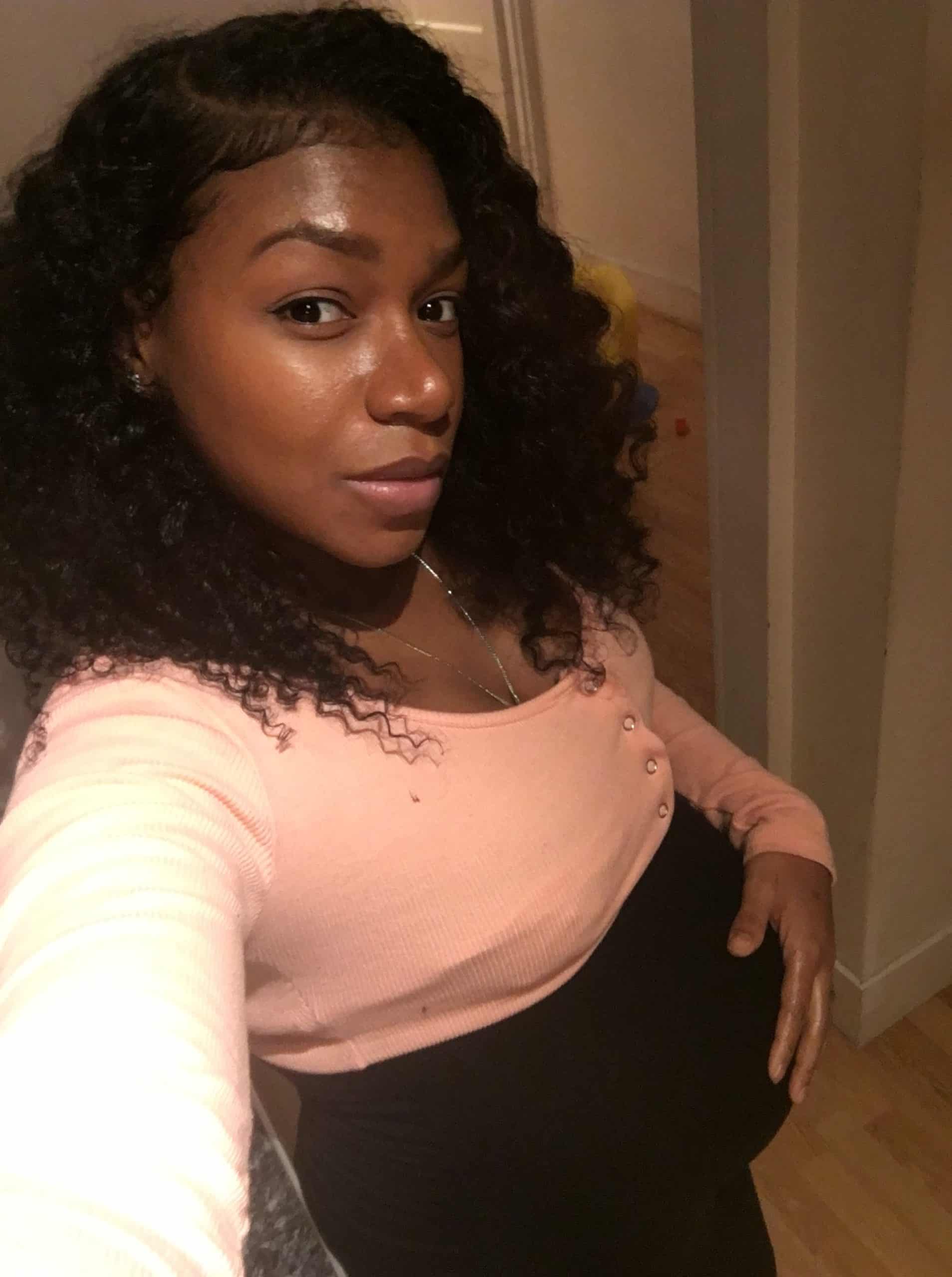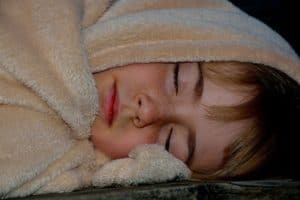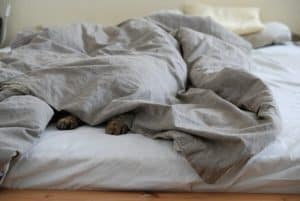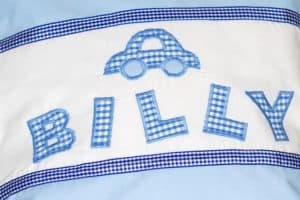Toddler safety is a primary concern for any parent.
Many new parents frequently ask, “can toddler suffocate under blanket” and the answer isn’t always straightforward.
There is so much to learn when it comes to bringing up children right and getting the balance between freedom and safety can be a tricky dilemma.
Editorial Pick: How To Discipline A Toddler
Other questions parents asked frequently about toddler bed safety is:
- When can toddler sleep with blanket?
- Can toddler suffocate under blanket?
- Duvets for toddlers advice
- Toddler pillow safety
Can Toddler Suffocate Under Blanket?
Most children aged 12 months+ are able to roll over and have the ability to move blankets away from their face.
According to the American Academy of paediatrics blankets and pillows increase the risk of suffocation and SIDS but the statistical likelihood of dying by suffocation under a blanket reduce significantly once your child reaches the toddler stage.
By the time your baby has reached toddler stages you both are probably getting a bit more sleep at night (at least that’s the idea!)
Sometimes this means that he/she can sleep through the night without waking up and other times they are still waking up intermittently.
Consequently, understanding safety and all the research surrounding toddlers sleeping is crucial to better sleep and more safety.
The guidelines that helped your baby sleep at night are different from toddler sleeping safety advice.
By the time your baby has reached toddler years they are no longer at risk of SIDS (Sudden Infant Death Syndrome)
Remember According to the American academy of paediatrics blankets and pillows increase the risk of suffocation so be sure to minimise there use below 12 months of age.
This is because most children aged 12 months + are able to roll over and have the ability to move blankets away from their face.
Can Toddler Suffocate Under Blanket: Additional Guidelines
At 1 year old your child has learnt the process of removing unwanted material and objects from themselves and therefore will be able to move or roll over if they feel a blanket to close to their face.
Of course, the younger your child is the more likely you need to take caution.
A 3-year-old, for example, would need very little observation when sleeping with a blanket.
A baby that has just turned 1, on the other hand, may need a bit more supervision at first just to ensure they are responding in a safe way to excessive blankets.
Try not to overpack the crib at night with other blankets or too many soft toys.
Safety, not comfort is your primary concern and the crib should remain relatively empty.
There is no need to give your toddler a pillow until they have transitioned from the crib into their own bed.
So now you know the answer to the question “can toddler suffocate under blanket?”, let’s move into when can toddler sleep with blanket?
When Can Toddler Sleep With Blanket?
Your toddler is able to sleep with a pillow when they are sleeping in bed with a blanket.
This is usually around the 18-month stage but can be later depending on your infant and their development.
Remember, most parents will not keep stuffed animals or any other type of stuffed toy in the crib or bed for safety.
A Toddler can sleep with a blanket any time after they reach 12 months, but by 18 months you should have no problem giving your toddler a thin blanket to sleep with at night.
Try your best to monitor your toddler at first to watch for any unusual signs of struggling or tension including a blanket in their crib.
Ensure that anything else that goes into your toddler’s crib is small enough so they can’t use it to climb on to get out of the crib.
Remember, your toddler’s crib should be used to sleep in, so try to avoid putting them in their crib for playtime.
This may have the unintended consequence of associating their crib with playtime and will make it harder for them to fall asleep at night.
Also, they may form the idea that stacking toys up to climb on is acceptable so it’s best to avoid overpacking the crib with anything more than a blanket and a few small soft toys.
Now you know when can toddler sleep with blanket, let’s investigate duvets for toddlers advice.
Duvets For Toddlers Advice
Duvets are not recommended for infants under the age of 12 months.
Try to use the right size od duvet to fit your toddler’s bed.
For example, don’t use a single duvet on a normal size cot bed or you put your child at the risk of overheating.
1. Lightweight
You want to look for a lightweight duvet cover so that your child can wriggle around without getting too hot.
Most toddlers are still learning to regulate temperature and usually are unable to remove clothing or put on more clothes without parents help.
This means that they may get too hot in the night if the duvet is too heavy.
We recommend a 4.5tg duvet in the summer months and around a 7 tog for those colder winter months.
Remember to monitor your house temperature as well.
If you regularly keep your heating high then you can probably get away with a 4.5tog all year round.
2. Washable
Most duvets are washable but double-check that you buy one with the washing machines symbol on it.
This will save you forking out more cash later when you start potty training and have plenty of night-time accidents.
3. Natural & Anti Allergy Duvets
You can go for a synthetic duvet filling or a natural duvet filling, but try to stay away from anything that may trigger allergies or cause allergic reactions.
You can get a cotton cover or cotton bed lined for either but a more natural duvet filling could provide more relief from nasty chemicals.
Natural duvet fillings also have the benefit of keeping your child cooler.
If you are unsure the best duvets for toddlers advice is to double-check with a paediatrician first.
Some children can have allergic reactions triggers by natural fillings so be very careful and ask an expert if you are unsure.
An anti-allergy duvet is better suited for children with allergies and asthmas.
This will help soothe them in the night and protect them against unnecessary sneezing and coughing.
Ultimately this will provide them with the most comfortable sleep possible.
More sleep for them means more sleep for you!
Toddler Pillow Safety
When thinking about toddler pillow safety it’s important you understand the risk of suffocation.
“The use of pillows is never recommended for infants due to the risk of suffocation,” says Dr. Maria Melendres paediatrician.
Most toddlers can have a pillow introduced to them around the age of 2″
You can use small pillows for toddlers. Try to keep this no bigger than 1 cm.
Don’t use a normal adult size pillow as this could result in posture issue and neck and back issues for your child.
One important toddler pillow safety tip is to remember that pillows are provided for comfort and many toddlers don’t actually need them.
If they are sleeping fine without one then you don’t need to introduce them to a pillow as soon as they turn 2.
Try to watch for signs that they are ready for a pillow.
This can be a simple as checking to see if they lay their head on a blanket or a stuffed toy when they fall asleep.
If this is the case then you can slowly start to introduce a toddler pillow.
Lastly, a smart toddler pillow safety tip is to try to use an anti-allergy pillow.
Understanding that the material each pillow is made from does have an effect on toddlers, especially those that are more sensitive than others.
Natural feathers are usually not recommended as they may cause a reaction in some children.
More Sleeping Guidelines For Toddlers
1. Move a toddler to a bed when they are tall enough
You can transition your toddler to a bed with a safety rail or side rail when they are about 35 inches tall.
Or you can wait until the highest of the rail is around three-quarters of your toddler’s height.
Parents usually make the switch when their toddler reaches 3 years old but technical between the ages of 18 months and 3 ½ will also work.
2. Keep the sleeping environment safe
You need to keep the crib as safe as possible by safeguarding it against most foreign objects that stay out of reach.
Examples include strings, window pulls and curtains, electric cords and heavy objects that could cave in and topple over.
3. Ensuring there are no hazards over your toddler’s bed is very important.
Examples are having a toddler bed too close to a wardrobe with heavy items on the top.
Remember to keep cribs well away from any heaters or electrical outlets that can produce extreme heat.
Also, remove any mobiles that may be hanging around the crib.
4. Try to protect against crib climbing
There are some things that are much easier to prevent than others and your toddler exploring their bed and surrounding objects is a guarantee.
You can avoid your child falling out of their crib by keeping it on the lowest possible level and limit the amount f stuffed animals your child has access to whilst in the crib.
If your toddler can still easily manage to climb out of the crib after taking these precautions then it’s probably a sign that they need their own bed.
5. Allow for comfortable sleeping
Once your toddler turns 1, they no longer need to sleep on their back.
They are now old enough to sleep on their stomach and side.
Whichever position they choose just go with it and don’t fuss too much over it.
The position they choose Is the most comfortable for them and will aid their sleeping.
6. When should I move my toddler out of the crib into a toddler bed?
This is definitely answered on a case by case basis.
Some toddlers can make the switch as early as 18 months while others can wait until after 3 and a half.
Try to wait until they are as close to 3 as possible as this seems to be a good general rule of thumb.
Remember there is no rush for your toddler to sleep in a bed and if they feel happy to sleep in their crib it is still safe to do so until they reach about 35 inches tall.
What about co-sleeping?
If you’ve always been co-sleeping with baby from the beginning then you’ve got no reason to stop now.
Of course, weigh up the pro’s and cons of co-sleeping and come to a conclusion that is right for you and your family.
If you don’t have the space for a separate bed then you’ll need to co-sleep until you do.
Talk to your paediatrician for effective ways that you can get into or out of co-sleeping.
When parents ask “Can Toddler Suffocate Under Blanket” I always recommend this page.
Toddler bed safety is important.
Hopefully with the tips above you’ll be able to sleep well in the knowledge that your toddler is safe and secure in their sleeping environment.
Here’s a quick video on What Age Can Babies Sleep With A Blanket.
Conclusion
Now that you have the correct facts about can toddler suffocate under blanket, it’s your paramount responsibility to keep your little one safe from any SIDS and suffocation.
With the above guidelines, toddlers can have a healthy sleep without parents worrying about their safety.
Related Post: How To Remove Pen Ink From Wall

Iesha is a loving mother of 2 beautiful children. She’s an active parent who enjoys indoor and outdoor adventures with her family. Her mission is to share practical and realistic parenting advice to help the parenting community becoming stronger.







